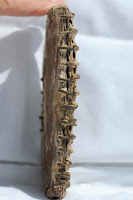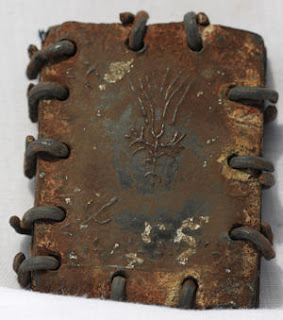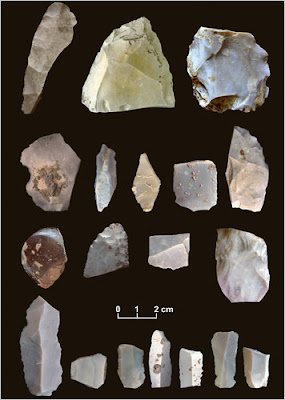
This morning, when I read news accounts of the new
Science article from Waters et al. and put them together with what I had already heard about the Buttermilk Creek Complex, it sounded to me like the Debra L. Friedkin Site was pretty good candidate for a pre-Clovis archaeological site. Now that I have seen the article and talked to some friends about it, I am a lot less impressed. The site may still turn out to be very early and very important, but there are big questions to be answered. The biggest are about the integrity of the site and its dating. What follows is going to be technical, because I think these issues are important for archaeology and science in general.
The dates from the Buttlermilk Creek Complex are "Optically Stimulated Luminescence," or OSL. To quote one of the news stories, the team:
used grains of quartz from the lower layer as tiny clocks. Electrons within these grains accumulate in "traps" inside the molecular structure at a steady, clocklike rate, explains Steven L. Forman, a geochronology specialist on the team and a professor at the University of Illinois at Chicago. Light releases them, so the accumulation indicates how long it has been since the grains last saw the light of day. Scientists measure that electron accumulation by exposing the grains to light in a lab, releasing the particles. In this case, Mr. Forman says, the number of escapees indicated the grains had been buried with the tools between 13,200 and 15,500 years ago, give or take a margin of error of about 1000 years.
To start with, 1000 years is a pretty big margin of error, and there are good reasons to suspect that the real margins of error for this data are even bigger. OSL dating is affected by the environmental conditions of the sample, including temperature and humidity. It so happens that the period between 15,000 years ago, the alleged age of the site, and 11,000 years ago was an era of dramatic fluctuations in temperature and humidity. Radiocarbon dating, which is much less affected by these conditions, is thrown off by hundreds of years in this period, and it has taken us decades of study with many sorts of dating (tree rings, ice layers, varves) to work out even an approximate translation of radiocarbon years into calendar years for this period. Surely it will be much more difficult to work out accurate translations of OSL years, and we have much, much less experience with this technique. Click on the image above and you will get a clue as to how far off these dates might be. The date from the Clovis layer (14,350 ± 910) is at least a thousand years too early, suggesting that the whole sequence should be pushed a millennium closer to the present.
Even more important are reservations about the stratigraphic integrity of the site, and the excavators' understanding of how artifacts move through the soil.
Yes, artifacts move around in the soil. I have seen sites where stone flakes had sunk a meter down through sandy soil in just 4,000 years. If you look at the data from Buttermilk Creek Complex, you see that the number of artifacts in each centimeter of their pre-Clovis layer declines steadily with depth, a pattern most often produced when the artifacts are drifting down from a layer above. This soil is clay, so artifacts will move less than they would through sand, but they will still move. Even Tom Dillehay, excavator of the controversial Monte Verde Site and usually a defender of pre-Clovis claims, expressed doubts about the integrity of the Friedkin Site. He noted that "the ecological conditions at the site, including rain-swept mud and remnants of creek flooding" could have displaced the artifacts.
Waters et al. try to address this question, but by their answer they display a gross misunderstanding of what is sometimes called the "biomantle" hypothesis. Waters et al. try to argue that their stone flakes could not have moved down through the soil because the flakes are bigger than the visible cracks and voids in the soil:
Crack infills constitute a minor portion of the soil volume with diameters rapidly decreasing from 2 cm near the surface to less than 1 cm at a depth of 1 m. Soil material between the crack infills is intact with few rodent burrows and limited root penetration (less than 2mm diameter). Only a few cracks reach the Clovis and Buttermilk Creek Complex levels, and crack apertures are less than 1 mm diameter, smaller than the microdebitage sizes from these levels.
But artifacts don't generally move through the soil by falling down cracks. They move because of the constant churning of the soil by earthworms, ants, roots, and other biological agents. The top foot or so (30 cm) of any temperate soil is the "biomantle," a zone that is in constant motion. At my old house I made a path by placing large pieces of slate on the ground surface, and five years later when we moved these slates had already disappeared beneath the sod, having sunk more than 5 centimeters (2 inches) down into the ground. I assure my readers that there were no cracks under the slates large enough for them to fall into.
Perhaps you are thinking, yes, but that is at the surface, and the Buttermilk Creek artifacts are more than a meter below the surface. True, but they were not always a meter below the surface; to judge from the stratigraphy, they were within 20 cm of the surface for at least a thousand years. As my example shows, stones can move several centimeters in just five years, so that thousand years is plenty of time for the Buttermilk Complex material to move 20 cm down from the Clovis layer.
If you are now thinking that my line of argument would invalidate the whole concept of stratigraphy on which archaeology rests, well, it does -- at least as an absolute rule. One should never assume that any one artifact is in the stratum where it was first deposited, and strata are more often distinguished statistically, by changes in the ratios of artifact types, than by absolute differences.
I am not arguing that the Buttermilk Complex material
did drift down from the Clovis layer, only that it might have. Why would I insist on that? Well, some of my acquaintances assert that the collection from the Friedkin Site looks very much like the material from the Aubrey Site, a site in central Texas that dates to the Clovis period. Why do the alleged pre-Clovis artifacts at Buttermilk Creek look so much like Clovis artifacts? The Friedkin Site is only 250 meters from the Gault Site, a major Clovis Site that has the distinction of producing the oldest widely accepted radiocarbon date from a Clovis Site. Because of this, and some other technical considerations, one theory about Clovis is that it developed in Texas among settlers who crossed from Asia and then kept moving south until they found somewhere warm to rest for a while. Since the Clovis culture seems to have developed in North American, the very first people here did not have it. It may turn out that the Friedkin Site is "pre-Clovis" in this sense, or perhaps proto-Clovis. But I very much doubt it will turn out to be 15,500 years old.
Clovis First is what scientists sometimes call a "robust" theory, meaning it fits with a large amount of data from many sources and has great explanatory power. The first non-archaeological evidence of humans in the Americas dates to Clovis times (13,300 to 12,900 years ago), including mass extinctions of animals, an increase in the number of fires, and other ecological factors. Clovis people acted like we expect humans to act on a new continent: they spread very rapidly and their numbers grew exponentially, carrying a nearly identical material culture across thousands of miles; they destroyed numerous animal species and otherwise reshaped the environment; they then began to diversify, and subsequent cultures in different parts of the continent become more and more distinct over time. The model was developed without any understanding of the rate of genetic change, and in fact early attempts to date the break between American and Asian populations produced estimates to 25,000 to 50,000 years ago. Those estimates have now been rejected and the consensus now is that almost all Native Americans descend from a single small group that left Asia 15,000 to 13,000 years ago, a perfect fit with Clovis First. While several possible pre-Clovis sites are compelling as individual sites, no one has formed them into a model of settlement that makes any sense. If people were here for 5,000 years before Clovis, as is often claimed, why did their numbers grow so slowly? Where is the environmental evidence for their presence? And how did Clovis spread so rapidly if the continent was already full of people? The explanatory power of the the Clovis First theory, and not some crotchety attachment to old ideas, is why many archaeologists have stuck with the model despite the growing number of sites with radiocarbon or OSL dates thousands of years earlier.
With every new claim of a pre-Clovis site, the pre-Clovis gang crows to the press about the obvious truth of their view and the absurd conservatism of the Clovis First dinosaurs; this time the prize for crassness goes to James Adovasio, who told the
NY Times: “The last spear carriers will die without changing their minds.” (Great idea for a Clovis First t-shirt: pictures of Clovis points under the legend "Spear Carrier.") But because Clovis First is such a powerful theory, it will take very strong evidence to overturn it, and a bunch of OSL dates with thousand-year sigmas from a stratum that looks like Clovis artifacts stomped into a muddy creek bank will not do it.
 The great epic of the ancient German world was the tale of Siegfried or Sigurd the dragon slayer. The story survives in two independent versions, the medieval German poem known as the Nibelungenlied and a prose telling from Iceland called The Saga of the Volsungs. The popularity of the story is attested by its many appearances in German art, including the numerous carved “Sigurd Stones” set up in Sweden illustrated with scenes from the hero’s career. I find it strange that both of these versions tell the same story, because that story is a mishmash of two separate, tenuously related tales. The first describes how the hero slew the dragon Fafnir and acquired a horde of cursed gold – the Norse version also includes the story of Sigurd’s family, the Volsungs, going back several generations – and the second is the story of a band of heroic warriors besieged and eventually killed by the army of Attila the Hun. The connection is that Sigurd or Siegfried marries into the family that ends up getting slaughtered by the Huns, but is betrayed and murdered by his brothers in law. They are incited by Brunhild, a woman he promised to marry but then abandoned. Sigurd/Siegfried’s widow then marries Attila the Hun, bringing him and his boundless greed into the story.
The great epic of the ancient German world was the tale of Siegfried or Sigurd the dragon slayer. The story survives in two independent versions, the medieval German poem known as the Nibelungenlied and a prose telling from Iceland called The Saga of the Volsungs. The popularity of the story is attested by its many appearances in German art, including the numerous carved “Sigurd Stones” set up in Sweden illustrated with scenes from the hero’s career. I find it strange that both of these versions tell the same story, because that story is a mishmash of two separate, tenuously related tales. The first describes how the hero slew the dragon Fafnir and acquired a horde of cursed gold – the Norse version also includes the story of Sigurd’s family, the Volsungs, going back several generations – and the second is the story of a band of heroic warriors besieged and eventually killed by the army of Attila the Hun. The connection is that Sigurd or Siegfried marries into the family that ends up getting slaughtered by the Huns, but is betrayed and murdered by his brothers in law. They are incited by Brunhild, a woman he promised to marry but then abandoned. Sigurd/Siegfried’s widow then marries Attila the Hun, bringing him and his boundless greed into the story. The story is dark and bloody. Everyone ends up dead, and not for any clear reason. The tale is sometimes taken to be the expression of a gloomy German consciousness, in which fate appears as a doomsday machine crushing all human hopes. It has also been one of the main channels by which ancient Germanic lore was passed down into modern times, and in the form of Wagner’s operas it is the most common way for modern people to encounter the ancient German world. So I assigned the Norse version, The Saga of the Volsungs, in my Celts to Vikings class. This version is shorter than the Nibelungenlied, easier to read, and less Christianized. I had doubts as to how this would work, but it has been great. My students liked the story and enjoyed analyzing what it says about fate and the human condition. They admired the courage of the characters, who are caught up in a tragedy from which they cannot escape but go down fighting instead of whining about their fates or blaming anybody for their troubles. They had interesting things to say about how it compared with the Irish stories we had read, and enjoyed speculating about how Celtic and Germanic culture were different.
The story is dark and bloody. Everyone ends up dead, and not for any clear reason. The tale is sometimes taken to be the expression of a gloomy German consciousness, in which fate appears as a doomsday machine crushing all human hopes. It has also been one of the main channels by which ancient Germanic lore was passed down into modern times, and in the form of Wagner’s operas it is the most common way for modern people to encounter the ancient German world. So I assigned the Norse version, The Saga of the Volsungs, in my Celts to Vikings class. This version is shorter than the Nibelungenlied, easier to read, and less Christianized. I had doubts as to how this would work, but it has been great. My students liked the story and enjoyed analyzing what it says about fate and the human condition. They admired the courage of the characters, who are caught up in a tragedy from which they cannot escape but go down fighting instead of whining about their fates or blaming anybody for their troubles. They had interesting things to say about how it compared with the Irish stories we had read, and enjoyed speculating about how Celtic and Germanic culture were different.








































